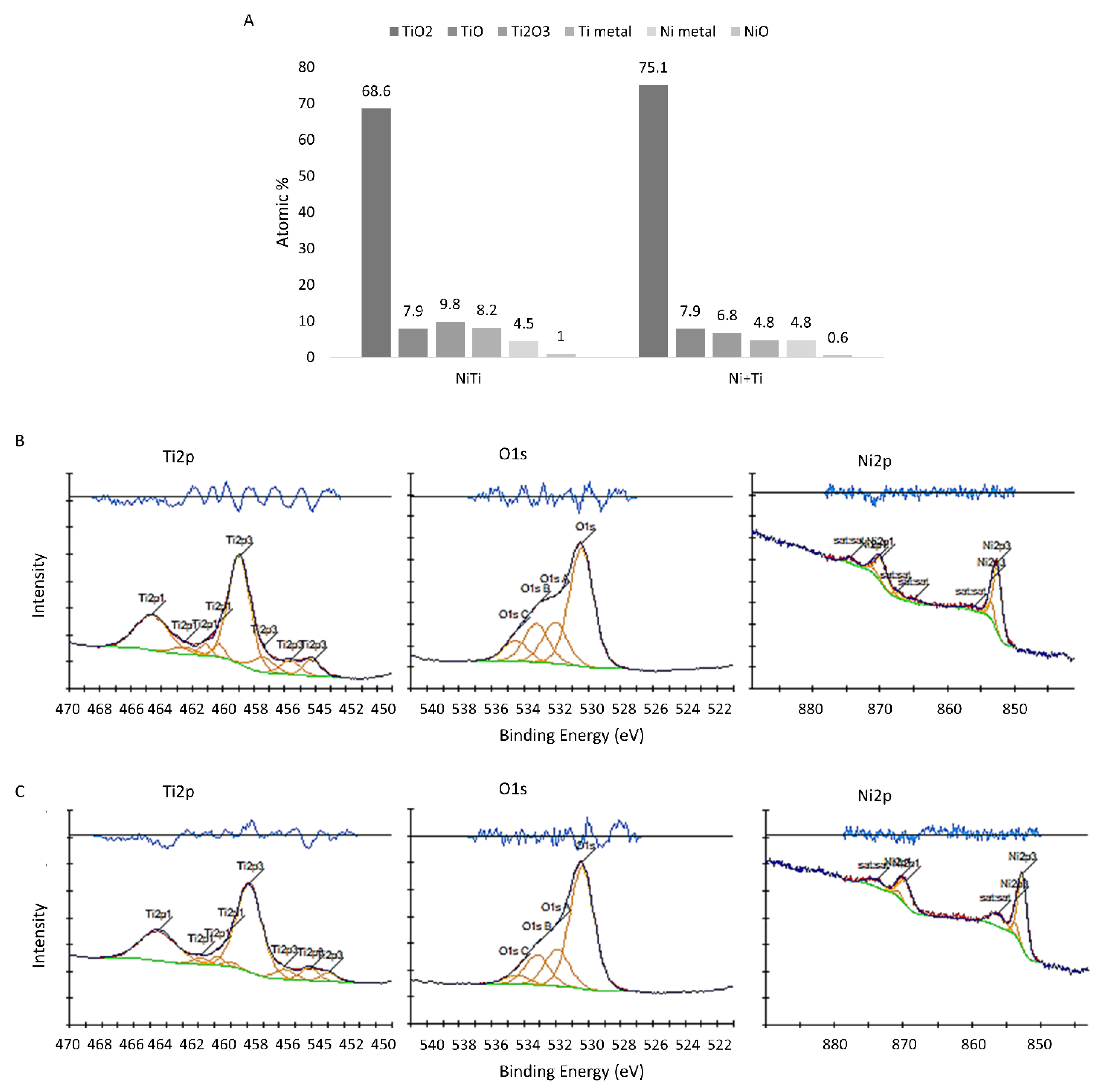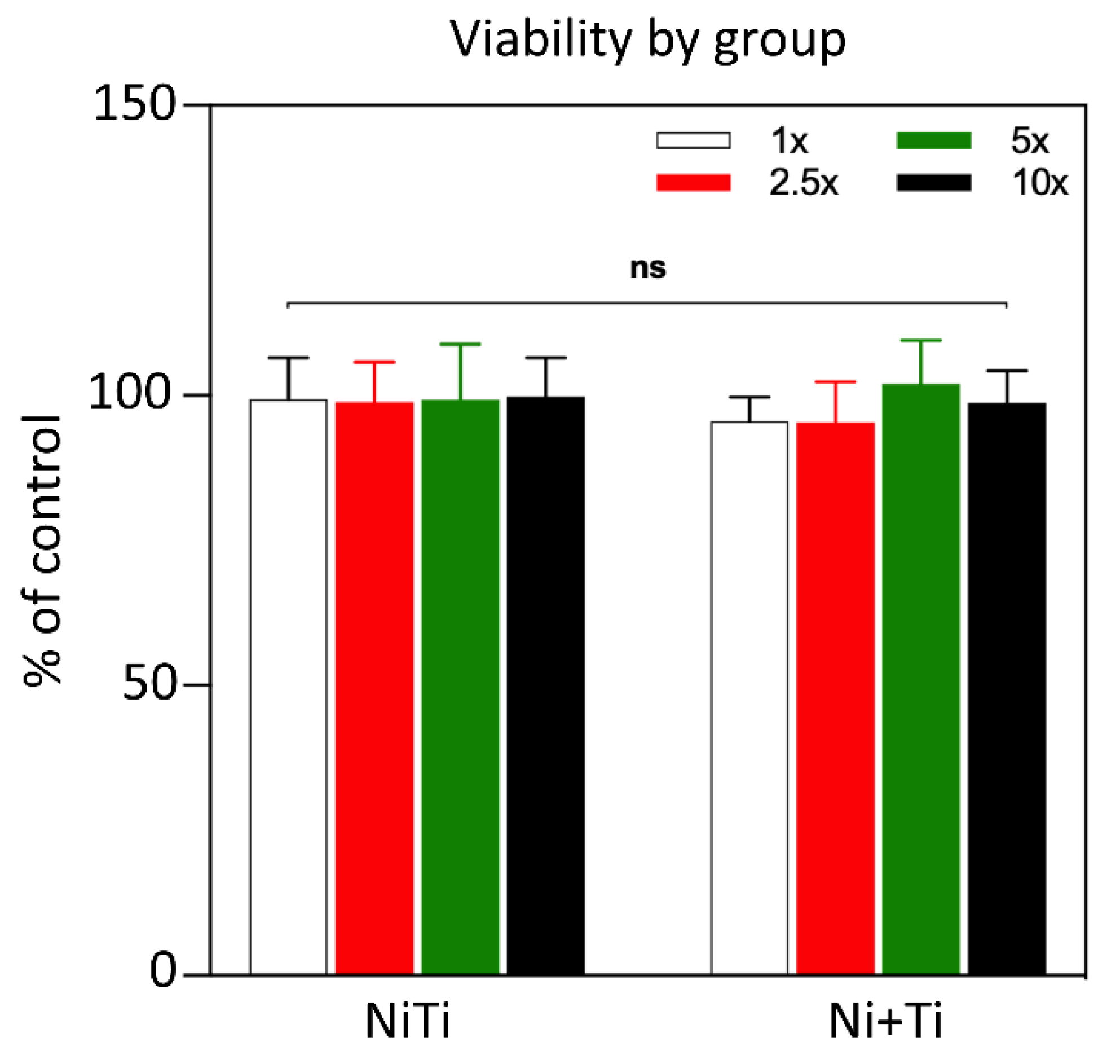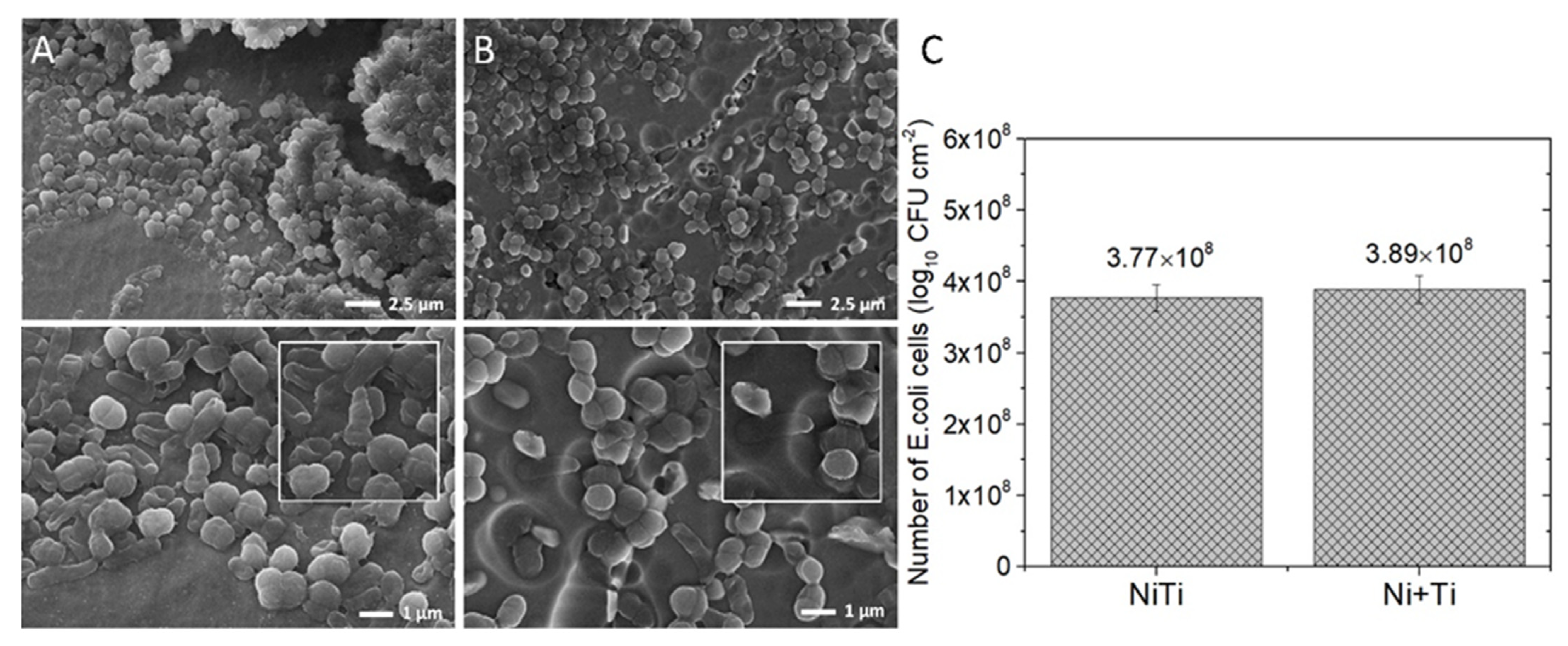Biological and Corrosion Evaluation of In Situ Alloyed NiTi Fabricated through Laser Powder Bed Fusion (LPBF)
Abstract
:1. Introduction
2. Results
2.1. Microstructure Characterisation
2.2. Surface Characterisation
2.3. Corrosion Behaviour
2.4. Biological Properties
3. Discussion
4. Materials and Methods
4.1. Materials and Fabrication Procedure
4.2. Microstructural Characterisation
4.3. Surface Chemical State Characterisation
4.4. Corrosion Behaviour
4.4.1. Electrochemical Procedure
4.4.2. Ni Ion Release
4.5. Biological Behaviour
4.5.1. Cytotoxicity Study
4.5.2. Bacterial Growth and Adhesion to the Surface
5. Conclusions
- The corrosion resistance of LPBF-printed parts produced from elementally blended pure Ni and Ti is slightly lower when compared to parts which were LPBF-printed from pre-alloyed NiTi powder; however, both materials show similar biocompatibility in terms of cytotoxicity.
- The low cytotoxicity and high passivation suggest that elementally blended pure Ni and Ti powders merit further investigation for use in biomedical applications.
- Further research on the LPBF manufacturing and post-printing process parameters and microstructure-dependent corrosion of elementally pure Ni and pure Ti is merited given the potential cost savings and improvements in corrosion and biocompatibility behaviour.
Author Contributions
Funding
Institutional Review Board Statement
Informed Consent Statement
Data Availability Statement
Acknowledgments
Conflicts of Interest
References
- Meena, V.K.; Kumar, P.; Kalra, P.; Sinha, R.K. Additive manufacturing for metallic spinal implants: A systematic review. Ann. 3D Print. Med. 2021, 3, 100021. [Google Scholar] [CrossRef]
- Andani, M.T.; Shayesteh Moghaddam, N.; Haberland, C.; Dean, D.; Miller, M.J.; Elahinia, M. Metals for bone implants. Part 1. Powder metallurgy and implant rendering. Acta Biomater. 2014, 10, 4058–4070. [Google Scholar] [CrossRef] [PubMed]
- Elahinia, M.H.; Hashemi, M.; Tabesh, M.; Bhaduri, S.B. Manufacturing and processing of NiTi implants: A review. Prog. Mater. Sci. 2012, 57, 911–946. [Google Scholar] [CrossRef]
- Kamali, P.; Dean, D.; Skoracki, R.; Koolen, P.G.L.; Paul, M.A.; Ibrahim, A.M.S.; Lin, S.J. The Current Role of Three-Dimensional Printing in Plastic Surgery. Plast. Reconstr. Surg. 2016, 137, 1045–1055. [Google Scholar] [CrossRef] [PubMed]
- Vance, A.; Bari, K.; Arjunan, A. Compressive performance of an arbitrary stiffness matched anatomical Ti64 implant manufactured using Direct Metal Laser Sintering. Mater. Des. 2018, 160, 1281–1294. [Google Scholar] [CrossRef]
- Schouman, T.; Schmitt, M.; Adam, C.; Dubois, G.; Rouch, P. Influence of the overall stiffness of a load-bearing porous titanium implant on bone ingrowth in critical-size mandibular bone defects in sheep. J. Mech. Behav. Biomed. Mater. 2016, 59, 484–496. [Google Scholar] [CrossRef]
- Zhang, Q.H.; Cossey, A.; Tong, J. Stress shielding in periprosthetic bone following a total knee replacement: Effects of implant material, design and alignment. Med. Eng. Phys. 2016, 38, 1481–1488. [Google Scholar] [CrossRef] [PubMed] [Green Version]
- Niinomi, M.; Nakai, M. Titanium-based biomaterials for preventing stress shielding between implant devices and bone. Int. J. Biomater. 2011, 2011, 836587. [Google Scholar] [CrossRef] [PubMed] [Green Version]
- Parthasarathy, J.; Starly, B.; Raman, S.; Christensen, A. Mechanical evaluation of porous titanium (Ti6Al4V) structures with electron beam melting (EBM). J. Mech. Behav. Biomed. Mater. 2010, 3, 249–259. [Google Scholar] [CrossRef] [PubMed]
- Andani, M.T.; Haberland, C.; Walker, J.M.; Karamooz, M.; Turabi, A.S.; Saedi, S.; Rahmanian, R.; Karaca, H.; Dean, D. Achieving biocompatible stiffness in NiTi through additive manufacturing. J. Intell. Mater. Syst. Struct. 2016, 27, 2661–2671. [Google Scholar] [CrossRef]
- Shayesteh Moghaddam, N.; Jahadakbar, A.; Amerinatanzi, A.; Dean, D.; Elahinia, M. Mechanical evaluation of the SLM fabricated, stiffness-matched, mandibular bone fixation plates. SPIE Intl. Soc. Opt. Eng. 2018, 1059610, 31. [Google Scholar]
- Karamooz-Ravari, M.R.; Taheri Andani, M.; Kadkhodaei, M.; Saedi, S.; Karaca, H.; Elahinia, M. Modeling the cyclic shape memory and superelasticity of selective laser melting fabricated NiTi. Int. J. Mech. Sci. 2018, 138–139, 54–61. [Google Scholar] [CrossRef]
- Kumaravel, V.; Nair, K.M.; Mathew, S.; Bartlett, J.; Kennedy, J.E.; Manning, H.G.; Whelan, B.J.; Leyland, N.S.; Pillai, S.C. Antimicrobial TiO2 nanocomposite coatings for surfaces, dental and orthopaedic implants. Chem. Eng. J. 2021, 416, 129071. [Google Scholar] [CrossRef]
- Jalvo, B.; Faraldos, M.; Bahamonde, A.; Rosal, R. Antimicrobial and antibiofilm efficacy of self-cleaning surfaces functionalized by TiO2 photocatalytic nanoparticles against Staphylococcus aureus and Pseudomonas putida. J. Hazard. Mater. 2017, 340, 160–170. [Google Scholar] [CrossRef] [PubMed]
- Won, Y.; Schwartzenberg, K.; Gray, K.A. TiO2-based transparent coatings create self-cleaning surfaces. Chemosphere 2018, 208, 899–906. [Google Scholar] [CrossRef] [PubMed]
- Li, L.Y.; Han, Z.Z.; Zeng, R.C.; Qi, W.C.; Zhai, X.F.; Yang, Y.; Lou, Y.T.; Gu, T.; Xu, D.; Duan, J.Z. Microbial ingress and in vitro degradation enhanced by glucose on bioabsorbable Mg–Li–Ca alloy. Bioact. Mater. 2020, 5, 902–916. [Google Scholar] [CrossRef]
- Rajasekar, A.; Ting, Y.P. Microbial corrosion of aluminum 2024 aeronautical alloy by hydrocarbon degrading bacteria bacillus cereus ACE4 and serratia marcescens ACE2. Ind. Eng. Chem. Res. 2010, 49, 6054–6061. [Google Scholar] [CrossRef]
- Nelson, V.V. Microbiologically Influenced Corrosion in Aluminium Alloys 7075 and 2024. In Aluminium Alloys-Recent Trends in Processing, Characterization, Mechanical Behavior and Applications; Maria, O.T., Ed.; IntechOpen: Rijeka, Croatia, 2017. [Google Scholar]
- Wataha, J.C.; Craig, R.G.; Hanks, C.T. The Release of Elements of Dental Casting Alloys into Cell-culture Medium. J. Dent. Res. 1991, 70, 1014–1018. [Google Scholar] [CrossRef] [PubMed]
- Jenko, M.; Godec, M.; Kocijan, A.; Rudolf, R.; Dolinar, D.; Ovsenik, M.; Gorenšek, M.; Zaplotnik, R.; Mozetic, M. A new route to biocompatible Nitinol based on a rapid treatment with H2/O2 gaseous plasma. Appl. Surf. Sci. 2019, 473, 976–984. [Google Scholar] [CrossRef]
- Azizi, A.; Jamilian, A.; Nucci, F.; Kamali, Z.; Hosseinikhoo, N.; Perillo, L. Release of metal ions from round and rectangular NiTi wires. Prog. Orthod. 2016, 17. [Google Scholar] [CrossRef] [Green Version]
- Farber, E.; Zhu, J.N.; Popovich, A.; Popovich, V. A review of NiTi shape memory alloy as a smart material produced by additive manufacturing. Mater. Today Proc. 2019, 30, 761–767. [Google Scholar] [CrossRef]
- Wang, X.; Kustov, S.; Van Humbeeck, J. A short review on the microstructure, transformation behavior and functional properties of NiTi shape memory alloys fabricated by selective laser melting. Materials 2018, 11, 1683. [Google Scholar] [CrossRef] [Green Version]
- Chen, X.; Liu, K.; Guo, W.; Gangil, N.; Siddiquee, A.N.; Konovalov, S. The fabrication of NiTi shape memory alloy by selective laser melting: A review. Rapid Prototyp. J. 2019, 25, 1421–1432. [Google Scholar] [CrossRef]
- Frenzel, J.; George, E.P.; Dlouhy, A.; Somsen, C.; Wagner, M.F.X.; Eggeler, G. Influence of Ni on martensitic phase transformations in NiTi shape memory alloys. Acta Mater. 2010, 58, 3444–3458. [Google Scholar] [CrossRef]
- Chembath, M.; Balaraju, J.N.; Sujata, M. Surface characteristics, corrosion and bioactivity of chemically treated biomedical grade NiTi alloy. Mater. Sci. Eng. C 2015, 56, 417–425. [Google Scholar] [CrossRef] [PubMed]
- Milošev, I.; Metikoš-Huković, M.; Petrović, Ž. Influence of preparation methods on the properties of self-assembled films of octadecylphosphonate on Nitinol: XPS and EIS studies. Mater. Sci. Eng. C 2012, 32, 2604–2616. [Google Scholar] [CrossRef]
- Venkateswarlu, K.; Rameshbabu, N.; Sreekanth, D.; Bose, A.C.; Muthupandi, V.; Subramanian, S. Fabrication and characterization of micro-arc oxidized fluoride containing titania films on Cp Ti. Ceram. Int. 2013, 39, 801–812. [Google Scholar] [CrossRef]
- Schroeder, V. Evolution of the passive film on mechanically damaged Nitinol. J. Biomed. Mater. Res. Part A 2009, 90A, 1–17. [Google Scholar] [CrossRef]
- Hang, R.; Ma, S.; Ji, V.; Chu, P.K. Corrosion behavior of NiTi alloy in fetal bovine serum. Electrochim. Acta 2010, 55, 5551–5560. [Google Scholar] [CrossRef]
- Pound, B.G. The electrochemical behavior of nitinol in simulated physiological solutions. J. Biomed. Mater. Res. Part A 2008, 85A, 1103–1113. [Google Scholar] [CrossRef]
- Sun, Y.; Zhao, Y.; Zhang, H.; Rong, Y.; Yao, R.; Zhang, Y.; Yao, X.; Hang, R. Corrosion behavior, antibacterial ability, and osteogenic activity of Zn-incorporated Ni-Ti-O nanopore layers on NiTi alloy. J. Mater. Sci. Technol. 2022, 97, 69–78. [Google Scholar] [CrossRef]
- Chang, M.; Su, J.; Hu, G.; Zhai, B.; Meng, D.; Sun, L.; Chen, Y.; Li, Y.; Cui, Y. Enhancement of corrosion resistance of a biomedical grade NiTi shape memory alloy by cyclic potentiodynamic polarization in PBS solution. Int. J. Electrochem. Sci. 2016, 11, 1092–1098. [Google Scholar]
- Yang, D.; Liu, C.; Liu, X.; Qi, M.; Lin, G. EIS diagnosis on the corrosion behavior of TiN coated NiTi surgical alloy. Curr. Appl. Phys. 2005, 5, 417–421. [Google Scholar] [CrossRef]
- Kim, Y.S.; Kim, J.G. Electrochemical corrosion behavior of a non-vascular, bi-stent combination, surgical esophageal nitinol stent in phosphate-buffered saline solution. Mater. Sci. Eng. C 2019, 94, 821–830. [Google Scholar] [CrossRef] [PubMed]
- Figueira, N.; Silva, T.M.; Carmezim, M.J.; Fernandes, J.C.S. Corrosion behaviour of NiTi alloy. Electrochim. Acta 2009, 54, 921–926. [Google Scholar] [CrossRef]
- Suematsu, N.J.; Iwamoto, J.; Ishii, Y.; Yamamoto, A. Dendrite pattern formation of sodium chloride crystal. Materials 2021, 14, 4434. [Google Scholar] [CrossRef]
- Young, K.D. Why spherical Escherichia coli dies: The inside story. J. Bacteriol. 2008, 190, 1497–1498. [Google Scholar] [CrossRef] [Green Version]
- Chmielewska, A.; Jahadakbar, A.; Wysocki, B.; Elahinia, M.; Święszkowski, W.; Dean, D. Chemical Polishing of Additively Manufactured, Porous, Nickel–Titanium Skeletal Fixation Plates. 3D Print. Addit. Manuf. 2021. ahead of print. [Google Scholar] [CrossRef]
- Chmielewska, A.; Wysocki, B.; Żrodowski, Ł.; Święszkowski, W. Hybrid solid-porous titanium scaffolds. In Transactions on Additive Manufacturing Meets Medicine; Infinite Science Publishing: Lubeck, Germany, 2019; Volume 1, p. 2. [Google Scholar]
- Vojtech, D.; Fojt, J.; Joska, L.; Novák, P. Surface treatment of NiTi shape memory alloy and its in fl uence on corrosion behavior. Surf. Coat. Technol. 2010, 204, 3895–3901. [Google Scholar] [CrossRef]
- Shabalovskaya, S.A.; Anderegg, J.; Laab, F.; Thiel, P.A.; Rondelli, G. Surface Conditions of Nitinol Wires, Tubing, and As-Cast Alloys. The Effect of Chemical Etching, Aging in Boiling Water, and Heat Treatment. J. Biomed. Mater. Res. Part B Appl. Biomater. 2003, 65, 193–203. [Google Scholar] [CrossRef]
- Shabalovskaya, S.A.; Tian, H.; Anderegg, J.W.; Schryvers, D.U.; Carroll, W.U.; Humbeeck, J. Van The influence of surface oxides on the distribution and release of nickel from Nitinol wires. Biomaterials 2009, 30, 468–477. [Google Scholar] [CrossRef] [PubMed]
- Nasakina, E.O.; Sudarchikova, M.A.; Sergienko, K.V.; Konushkin, S.V.; Sevost’Yanov, M.A. Ion release and surface characterization of nanostructured nitinol during long-term testing. Nanomaterials 2019, 9, 1569. [Google Scholar] [CrossRef] [PubMed] [Green Version]
- Guda Vishnu, K.; Strachan, A. Size effects in NiTi from density functional theory calculations. Phys. Rev. B 2012, 85, 014114. [Google Scholar] [CrossRef] [Green Version]
- Stergioudi, F.; Vogiatzis, C.A.; Pavlidou, E.; Skolianos, S.; Michailidis, N. Corrosion resistance of porous NiTi biomedical alloy in simulated body fluids. Smart Mater. Struct. 2016, 25, 095024. [Google Scholar] [CrossRef]
- Zhang, S.; Liang, X.; Gadd, G.M.; Zhao, Q. Advanced titanium dioxide-polytetrafluorethylene (TiO2-PTFE) nanocomposite coatings on stainless steel surfaces with antibacterial and anti-corrosion properties. Appl. Surf. Sci. 2019, 490, 231–241. [Google Scholar] [CrossRef]
- Zhao, Q.; Liu, Y.; Wang, C.; Wang, S.; Müller-Steinhagen, H. Effect of surface free energy on the adhesion of biofouling and crystalline fouling. Chem. Eng. Sci. 2005, 60, 4858–4865. [Google Scholar] [CrossRef]
- Malte, H. The DLVO theory in microbial adhesion. Colloids Surf. B Biointerfaces 1999, 14, 105–119. [Google Scholar]
- Bayoudh, S.; Othmane, A.; Mora, L.; Ben Ouada, H. Assessing bacterial adhesion using DLVO and XDLVO theories and the jet impingement technique. Colloids Surf. B Biointerfaces 2009, 73, 1–9. [Google Scholar] [CrossRef] [PubMed]
- Liu, C.; Geng, L.; Yu, Y.F.; Zhang, Y.; Zhao, B.; Zhang, S.; Zhao, Q. Reduction of bacterial adhesion on Ag-TiO2 coatings. Mater. Lett. 2018, 218, 334–336. [Google Scholar] [CrossRef]
- Meng, L.; Li, Y.; Pan, K.; Zhu, Y.; Wei, W.; Li, X.; Liu, X. Colloidal particle based electrodeposition coatings on NiTi alloy: Reduced releasing of nickel ions and improved biocompatibility. Mater. Lett. 2018, 230, 228–231. [Google Scholar] [CrossRef]
- Chmielewska, A.; Wysocki, B.; Buhagiar, J.; Michalski, B.; Adamczyk-Cieślak, B.; Gloc, M.; Święszkowski, W. In situ alloying of NiTi: Influence of Laser Powder Bed Fusion (LBPF) scanning strategy on chemical composition. Mater. Today Commun. 2021, 30, 103007. [Google Scholar] [CrossRef]
- Shi, Z.; Liu, M.; Atrens, A. Measurement of the corrosion rate of magnesium alloys using Tafel extrapolation. Corros. Sci. 2010, 52, 579–588. [Google Scholar] [CrossRef]
- ASTM International. F3306 Standard Test Method for Ion Release Evaluation of Medical Implants; ASTM International: West Conshohocken, PA, USA, 2019; pp. 1–6. [Google Scholar] [CrossRef]
- ASTM International. F2129 Standard Test Method for Conducting Cyclic Potentiodynamic Polarization Measurements to Determine the Corrosion Susceptibility of Small Implant Devices 1; ASTM International: West Conshohocken, PA, USA, 2019; pp. 1–9. [Google Scholar] [CrossRef]
- Wang, M.O.; Etheridge, J.M.; Thompson, J.A.; Vorwald, C.E.; Dean, D.; Fisher, J.P. Evaluation of the In Vitro Cytotoxicity of Cross-Linked Biomaterials. Biomacromolecules 2013, 14, 1321–1329. [Google Scholar] [CrossRef] [Green Version]
- Chmielewska, A.; Macdonald, T.; Ibrahim, H.; McManus, T.; Lammel Lindemann, J.; Smith, P.; Rong, L.; Luo, A.; Advincula, R.; Swieszkowski, W.; et al. Biocompatibility of a novel heat-treated and ceramic-coated magnesium alloy (Mg-1.2Zn-0.5Ca-0.5Mn) for resorbable skeletal fixation devices. MRS Commun. 2020, 10, 467–474. [Google Scholar] [CrossRef]
- International Organization for Standarization. ISO 10993-5:2009 Biological Evaluation of Medical Devices—Part 5: Tests for In Vitro Cytotoxicity; International Organization for Standarization: Geneva, Switzerland, 2009; pp. 1–34. [Google Scholar]
- International Organization for Standarization. ISO 10993-12:2009 Biological Evaluation of Medical Devices—Part 12: Sample Preparation and Reference Materials; International Organization for Standarization: Geneva, Switzerland, 2009; pp. 1–28. [Google Scholar]
- Guerra, C.; Ringuedé, A.; Azocar, M.I.; Walter, M.; Galarce, C.; Bedioui, F.; Cassir, M.; Sancy, M. Corrosion analysis of AISI 430 stainless steel in the presence of Escherichia coli and Staphylococcus aureus. Corros. Sci. 2021, 181, 109204. [Google Scholar] [CrossRef]
- Javed, M.A.; Borges, B.; Cirino, V.; Osman, A.; Wade, S.A. Effect of metal substrate on initial attachment of E. coli bacteria and subsequent microbiologically influenced corrosion. In Proceedings of the Corrosion and Prevention 2015, Adelaide, Australia, 15–18 November 2015. [Google Scholar]
- Javed, M.A.; Stoddart, P.R.; McArthur, S.L.; Wade, S.A. The effect of metal microstructure on the initial attachment of Escherichia coli to 1010 carbon steel. Biofouling 2013, 29, 939–952. [Google Scholar] [CrossRef]








| Materials | Ecorr (V/Ref) | icorr (nA∙cm−2) | Eb (V/Ref) |
|---|---|---|---|
| NiTi | −0.13 | 130 | −1.28 |
| Ni+Ti | −0.27 | 201 | −1.24 |
| Rs (Ω cm2) | Rfilm (Ω cm2) | CPEfilm (µF cm−2) | n1 | Rct (Ω cm2) | CPEdl (µF∙cm−2) | n2 | |
|---|---|---|---|---|---|---|---|
| NiTi | 6 | 20 × 106 | 15 | 0.96 | - | - | - |
| Ni+Ti | 8 | 7 × 103 | 79 | 0.83 | 9 × 106 | 90 | 0.82 |
| Material | Elements (wt.%) | ||||||
|---|---|---|---|---|---|---|---|
| Ti | Ni | C | O | N | H | Fe | |
| NiTi | bal. | 55.7 | 0.005 | 0.046 | 0.007 | 0.0006 | |
| Ti | bal. | 0.01 | 0.13 | 0.1 | 0.001 | 0.11 | |
| Ni | 99.9 | 0.017 | <0.1 | ||||
| Laser Power P [W] | Scanning Speed v [mm/s] | Hatch Distance h [µm] | ||
|---|---|---|---|---|
| NiTi | melting | 108 | 100 | 120 |
| remelting | 22 | 500 | 120 | |
| Ni+Ti | melting | 30 | 500 | 30 |
| remelting | 25 | 500 | 30 |
Publisher’s Note: MDPI stays neutral with regard to jurisdictional claims in published maps and institutional affiliations. |
© 2021 by the authors. Licensee MDPI, Basel, Switzerland. This article is an open access article distributed under the terms and conditions of the Creative Commons Attribution (CC BY) license (https://creativecommons.org/licenses/by/4.0/).
Share and Cite
Chmielewska, A.; Dobkowska, A.; Kijeńska-Gawrońska, E.; Jakubczak, M.; Krawczyńska, A.; Choińska, E.; Jastrzębska, A.; Dean, D.; Wysocki, B.; Święszkowski, W. Biological and Corrosion Evaluation of In Situ Alloyed NiTi Fabricated through Laser Powder Bed Fusion (LPBF). Int. J. Mol. Sci. 2021, 22, 13209. https://doi.org/10.3390/ijms222413209
Chmielewska A, Dobkowska A, Kijeńska-Gawrońska E, Jakubczak M, Krawczyńska A, Choińska E, Jastrzębska A, Dean D, Wysocki B, Święszkowski W. Biological and Corrosion Evaluation of In Situ Alloyed NiTi Fabricated through Laser Powder Bed Fusion (LPBF). International Journal of Molecular Sciences. 2021; 22(24):13209. https://doi.org/10.3390/ijms222413209
Chicago/Turabian StyleChmielewska, Agnieszka, Anna Dobkowska, Ewa Kijeńska-Gawrońska, Michał Jakubczak, Agnieszka Krawczyńska, Emilia Choińska, Agnieszka Jastrzębska, David Dean, Bartłomiej Wysocki, and Wojciech Święszkowski. 2021. "Biological and Corrosion Evaluation of In Situ Alloyed NiTi Fabricated through Laser Powder Bed Fusion (LPBF)" International Journal of Molecular Sciences 22, no. 24: 13209. https://doi.org/10.3390/ijms222413209
APA StyleChmielewska, A., Dobkowska, A., Kijeńska-Gawrońska, E., Jakubczak, M., Krawczyńska, A., Choińska, E., Jastrzębska, A., Dean, D., Wysocki, B., & Święszkowski, W. (2021). Biological and Corrosion Evaluation of In Situ Alloyed NiTi Fabricated through Laser Powder Bed Fusion (LPBF). International Journal of Molecular Sciences, 22(24), 13209. https://doi.org/10.3390/ijms222413209












